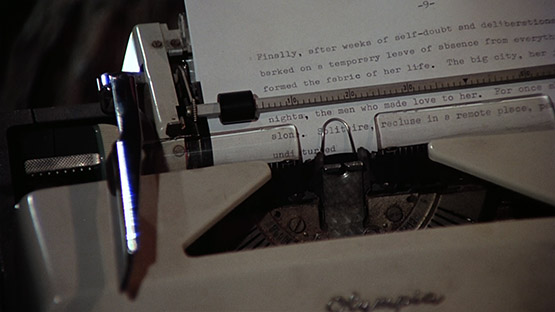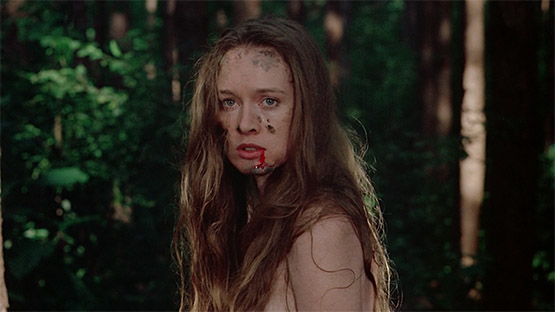(Note: The film had a limited release in 1978 as Day of the Woman and was later given a major release in 1980 as I Spit on Your Grave. )
It only seemed right to have I Spit on Your Grave be the first single-film analysis on Dark Side Cinema. Not only was it highly recommended to me by several sources, but I had also somehow avoided seeing it up until now and I wanted to examine something fresh without any previous bias. The movie is 36 years old and the plot is well-known, so spoilers lie ahead, if it’s even possible for there to be spoilers of a three-decades old film.
It would be easy to dismiss I Spit on Your Grave as nothing more than an exploitation film, to refuse to look past the graphic rape and violence and see only pure shock value. This would be a discredit to the film, however, as there is more depth than can be expected of most exploitation films. The film is polarizing among the critical world: some view it as the worst kind of trash ever produced, while others commend its feminist stance and are quick to explore the sociopolitical statements contained within. Regardless of where the viewer stands, it is undeniable that the film makes you feel something, be it disgust, horror, shock, or morbid curiosity. This ain’t no popcorn flick.
The plot of I Spit on Your Grave is pretty basic: aspiring writer Jennifer leaves the hustle and bustle of the city for a cabin in upstate New York, where she plans on writing her first novel. She is discovered swimming in the nude by Matthew, a grocery-delivery man with some sort of mental disability. He tells his buddies about her and they decide that they’re going to catch her and give her to Matthew to have sex with and “pop his cherry”. When Matthew initially refuses, the other men take their turns raping her. There are three extended rape scenes in different locations and each is as brutal as the last. After they are finished with her, one of the men tells Matthew to kill her and gives him a knife. Matthew is unable to kill her and instead wipes the knife in the blood on her cheek, telling the men that he did the deed.
The second half of the film is Jennifer’s revenge. She starts by luring Matthew to the house by ordering groceries, then seducing him by the river. She loops a rope around his neck during sex and hangs him. Done with Matthew, she goes after the group’s ringleader, Johnny. She gets him to come back to her house with promises of sex and cuts off his penis in the bathtub, then leaves him to bleed to death. Jennifer kills the final two men out on the river that they tormented her on in the beginning of the film, killing one with an axe and the other with the motor of his own boat.
Roger Ebert, in his 1980 review of the film, was appalled by the film, calling it “sick, reprehensible and contemptible”. Needless to say, he gave it a thumbs down. A majority of critics lambasted the movie, denouncing the amount of brutal violence and the graphic depictions of rape. It was only years later that academics began dissecting the film to examine the feminist viewpoint represented.
There is a lot more going on in I Spit on Your Grave than excessive nudity and blood. The film owes a great deal to 1972’s Deliverance, as the overall atmosphere of the film is very similar. There is a very genuine sense of isolation, of being cut off from civilization. In a scene early on in the film, when Jennifer is working on her manuscript, the words “alone”, “solitaire”, “recluse” and “remote” are all displayed on screen.
The general sense of malaise and unease quickly turns into genuine discomfort and fear when the men capture Jennifer and the rapes begin. Each rape is progressively more violent and degrading. The downward spiral of violation includes anal rape on a rock and a great deal of beating on the floor of her own cabin home after she begs the final rapist not to touch her. This is by far the film’s most vulgar scene, starting with the rape of Jennifer by Matthew, then followed by one of the other men penetrating her with a liquor bottle, forcing his genitals in her mouth, and beating her for “lying there”. It is hard to find anything of artistic merit in any of these scenes, but it’s there for those willing to really look.
The first thing that needs to be commended is the acting of Camille Keaton, the woman who portrayed Jennifer. The rest of the acting in the movie ranges from poor to mediocre, but she is amazing. She is capable of expressing incredible amounts of emotion through only her eyes. When she is captured by her rapists after her initial escape in the woods, the look of terror and hatred on her face is as close to the genuine article as possible. She endured a great deal to portray the character and she did it astonishingly well.
Jennifer is a strong female protagonist who eventually gets the ultimate revenge on those who have wronged her. This is pretty standard exploitation film fare, but Jennifer’s story has some interesting touches. During the final rape scene, for instance, her attackers read her manuscript aloud, make fun of it, and then rip it into pieces. Not only have they assaulted her sexually and physically, but this scene demonstrates that they have torn apart her sense of self as well. That she uses sex to lure the men to their death is worth examining too – she is regaining control of herself and her body. The fact that she castrates Johnny, literally removing his weapon from him, is just icing on the cake. The whole thing is one big Freudian mess and it’s not hard to believe that the original title of the film was Day of the Woman.
If this is a feminist film, it’s either extremely disparaging toward men or it is a revenge fantasy in the purest sense. There is absolutely a kind of catharsis watching Jennifer retaliate against those who have wronged her. If this is not an argument against men, then it is definitely wish fulfilment for those who have been wronged by them. Director Meir Zarchi has stated several times that he was inspired to make the film when he discovered a young woman that had just been raped and attempted to take her to the police, who in turn were callous and unhelpful. If that is in fact the case, it makes the idea that this is a feminist film that much more feasible.
One interesting thing Zarchi did with the film was create two different sets of time – before the rapes and after. He repeats several shots from the beginning of the movie later in the film, though there are subtle differences to highlight the changes that have occurred. Two of the most powerful of these are the now-famous beginning scene in which Jennifer is driving from the city out into the country. She is wearing brightly colored makeup, her hair is done up nicely, and she looks hopeful. After the rapes she is shown driving again, with scars on her face and neck, her hair under a bandanna, and large sunglasses covering her eyes. This shot is darker and she even passes a cemetery on her way. highlighting the incredible change in her from the beginning.
In the second set of double-shots, Jennifer is canoeing along the river by herself. It is peaceful, there are flowers behind her, and the men are nowhere in sight. After her abduction by the men, her canoe is left to float on it’s own. There is something innately haunting about the shot of the canoe, bright red against the browns of the river, void of a master.
There are some pretty major detractors from this film. It is clearly very low-budget, with red paint for blood and shaky-cam to rival the first Evil Dead. The script revolves around a thin plot with about-average dialogue, performed by less-than-brilliant actors (aside from Keaton). The sound quality is absolutely awful. It’s no wonder that Zarchi was excited to be a part of the 2010 remake and give his film a much-needed facelift. (The remake, of course, is a topic for another day.)
So what is I Spit on Your Grave? Is it a feminist horror film? An exploitation shock-fest? Something in-between? Whatever it is, as my film friend and fellow CHUD writer put it, it’s “one hell of a thing.”
The Breakdown
Violence: 6/10 While the film graphically depicts rape, murder, and castration, it’s also really not that gory.
Sex: 9/10 Lots and lots of male and female full-frontal nudity, but you really don’t want to watch any of the sex in this film unless you have some kind of sick fetish.
Entertainment value: 3/10 This is an uncomfortable film to watch and only the revenge bits are really entertaining at all.
This movie is for: Arthouse fans, psychoanalysts, feminist theory majors
Overall rating: 6/10 Fascinating, but poorly made and difficult to watch.



